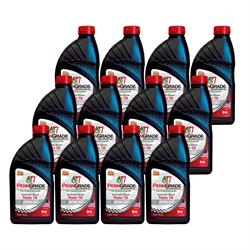What is ZDDP - Benefits of Zinc in Oil
Modern engines are vastly different than what the hobbyist racer or hot rodder has in their specialty vehicle. Engines have changed significantly since the 1950s, and mainstream motor oil has followed suit. Today’s parts-store engine oil is engineered for modern engines, not your engine. This means your engine needs specialty oil from a specialty retailer, like Speedway Motors.
Benefits of ZDDP in Oil
Zinc dialkyldithiophosphate, commonly known as ZDDP or “zinc” is an anti-wear additive that creates a surface layer boundary inside your engine. This zinc additive sticks to metal, minimizing metal-on-metal contact in high load situations, when the oil film thins out. Plus, this boundary layer has the added benefit of minimizing corrosion due to oxidation, so engine internals stay rust-free. As such, ZDDP is great for engines that have more inherent valvetrain, piston and bearing friction, as well as engines that sit for extended periods of time.
Zinc in Oil - Not a Myth
ZDDP was first used in mainstream motor oil in the 1940's, primarily for its anti-corrosion benefits. Zinc in oil kept the lead-copper bearings of the day from oxidizing, but it was also found to significantly reduce wear. As a result, ZDDP additive levels in mainstream oil gradually increased up until the early 1990s, peaking around 1,200-1,400 parts-per-million.
Starting in the early 2000's, hot rodders, race teams and automotive enthusiasts began seeing an increase in camshaft and lifter failures, particularly with flat-tappet cams. Issues with flat camshaft lobes became common place. Enthusiasts began scratching their heads trying to figure out why these failures happened. Valve spring pressures were checked, lifters were matched to the cam, everything was put together correctly, and brand-name oil was used - but there was still a failure.
Significantly reduced levels of ZDDP oil additive in mainstream oil were to blame. Looking back, we know these things changed parts-store oil forever:
- Addition of sensitive emissions equipment like O2 sensors and catalytic converters
- Better fuel economy via more efficient engines (roller valvetrains, georotor oil pumps, thinner piston rings, etc.)
- Introduction of ethanol in gasoline (first E10, now E15)
- Increased levels of detergents, extending oil change intervals
Modern parts-store oil is engineered with all of these things in mind. Obviously, your Eisenhower-era cam-in-block engine has a different set of engineering challenges. It needs different engine oil additives.
Best Oil for Older Cars and Race Engines
Oil composition has changed greatly over the years and while a certain brand/type of oil may have worked great in the past, the reduction of zinc in oil could now spell disaster for your engine. ZDDP additive levels have gradually decreased since the 1990s in ALL mainstream oils, including diesel oils. In fact, the APIs new “SP” oil specification, set for release in 2020, is the first to not have been tested on an OHV pushrod or flat tappet engine.
For certification, API oils are tested on engines with a maximum 215 lbs. (open) valve spring pressure. Typical performance engines are equipped with valve springs over 280 lbs. (open) pressure. If you have an engine with a flat tappet cam, you need to be sure that the oil you use has enough ZDDP in it to create that layer of protection between the cam and lifters.
Motor Oil is Application-Specific
Just like all the parts in your engine, motor oil is designed for a specific usage and operating range. ZDDP additive packages will vary between applications, so be sure to match your oil to your vehicle: break-in oils, classic car oils, racing oils, diesel truck oils, or modern performance oils. Here at Speedway Motors, we’ve done the research for you. Our business is run by enthusiasts who’ve been building, racing and rebuilding engines for 3 generations. We know what motor oil additives you need, and which oils perform best.
See our full line of high-zinc oils, ZDDP oil additives and break-in oils by visiting our engine oil page.







